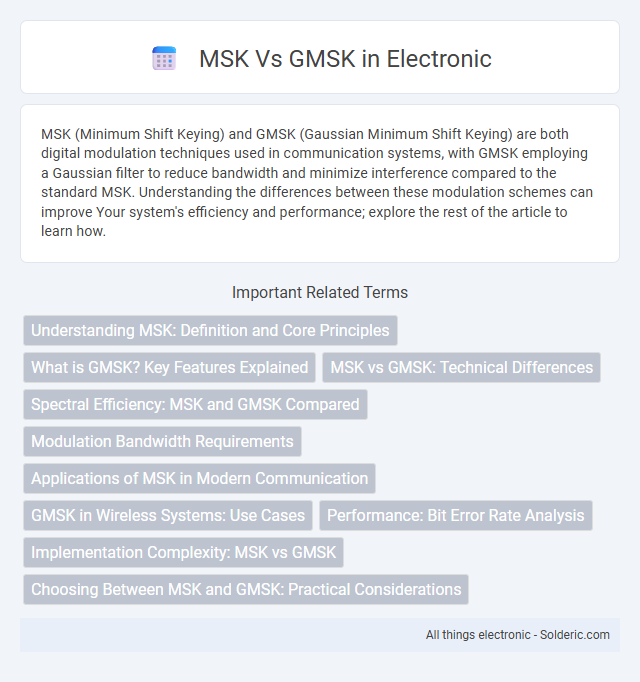MSK (Minimum Shift Keying) and GMSK (Gaussian Minimum Shift Keying) are both digital modulation techniques used in communication systems, with GMSK employing a Gaussian filter to reduce bandwidth and minimize interference compared to the standard MSK. Understanding the differences between these modulation schemes can improve Your system's efficiency and performance; explore the rest of the article to learn how.
Comparison Table
| Feature | MSK (Minimum Shift Keying) | GMSK (Gaussian Minimum Shift Keying) |
|---|---|---|
| Modulation Type | Continuous phase frequency modulation | Gaussian-filtered MSK |
| Bandwidth Efficiency | Moderate | High (due to Gaussian filtering) |
| Signal Spectrum | Relatively wider sidebands | Narrower sidebands, reduced out-of-band emissions |
| Error Performance | Good bit error rate (BER) | Similar BER with improved spectral efficiency |
| Applications | Simple digital communication systems | Used in GSM cellular networks |
| Complexity | Lower | Higher due to Gaussian filtering and pulse shaping |
| Power Efficiency | Good | Improved power efficiency due to spectrum shaping |
Understanding MSK: Definition and Core Principles
MSK (Minimum Shift Keying) is a continuous-phase frequency shift keying technique characterized by its constant envelope and minimum frequency spacing, allowing efficient spectral usage and reduced interference. Unlike GMSK (Gaussian Minimum Shift Keying), which applies Gaussian filtering to MSK's signal for smoother phase transitions and lower sideband power, MSK maintains a rectangular frequency pulse shape for simplicity and robustness. Understanding MSK's core principles helps optimize your communication system's performance by balancing spectral efficiency and signal resilience.
What is GMSK? Key Features Explained
GMSK (Gaussian Minimum Shift Keying) is a digital modulation scheme that improves spectral efficiency by applying a Gaussian filter to smooth the phase transitions of the MSK (Minimum Shift Keying) signal, resulting in reduced bandwidth and lower out-of-band emissions. Key features include continuous phase modulation, constant envelope transmission enabling efficient power amplification, and superior resistance to intersymbol interference compared to MSK. You benefit from GMSK's ability to provide reliable data communication with optimized bandwidth usage, widely used in GSM cellular networks.
MSK vs GMSK: Technical Differences
MSK (Minimum Shift Keying) features a constant envelope and continuous phase, enabling efficient use of power amplifiers and minimal signal distortion. GMSK (Gaussian Minimum Shift Keying) enhances MSK by applying a Gaussian filter to smooth phase transitions, reducing spectral bandwidth and adjacent channel interference. Your choice between MSK and GMSK depends on the need for spectral efficiency versus implementation simplicity in communication systems.
Spectral Efficiency: MSK and GMSK Compared
MSK (Minimum Shift Keying) offers spectral efficiency by maintaining constant envelope and minimum frequency shift, resulting in reduced sideband power and improved bandwidth utilization. GMSK (Gaussian Minimum Shift Keying) further enhances spectral efficiency through Gaussian filtering of the input data, which smooths transitions and reduces out-of-band emissions, enabling tighter channel spacing. The controlled intersymbol interference in GMSK allows for more efficient spectra compared to MSK, making GMSK preferable in bandwidth-constrained wireless communication systems like GSM.
Modulation Bandwidth Requirements
MSK (Minimum Shift Keying) requires a modulation bandwidth approximately equal to twice the bit rate, offering efficient spectral utilization with minimal side lobes. GMSK (Gaussian Minimum Shift Keying) further reduces bandwidth by filtering the baseband signal with a Gaussian filter, resulting in narrower spectral occupancy than MSK at the cost of intersymbol interference trade-offs. GMSK's bandwidth efficiency makes it the preferred modulation scheme in GSM systems where spectrum conservation is critical.
Applications of MSK in Modern Communication
MSK (Minimum Shift Keying) is widely used in modern communication systems such as satellite communications, digital radio, and GSM for its spectral efficiency and constant envelope properties, which reduce signal distortion. Its robustness against multipath fading makes it ideal for mobile and wireless applications requiring reliable data transmission. You benefit from MSK's efficient bandwidth usage and low error rates, enhancing the performance of real-time communication networks.
GMSK in Wireless Systems: Use Cases
GMSK (Gaussian Minimum Shift Keying) is widely used in wireless communication systems such as GSM (Global System for Mobile Communications) due to its spectral efficiency and reduced interference. The Gaussian filter in GMSK smooths phase transitions, which minimizes sideband power and enhances signal quality in mobile networks and Bluetooth applications. You benefit from GMSK's robustness in environments with limited bandwidth, making it ideal for reliable voice and data transmission in cellular systems.
Performance: Bit Error Rate Analysis
MSK (Minimum Shift Keying) offers a constant envelope and spectrally efficient modulation, resulting in a lower bit error rate (BER) compared to standard GMSK (Gaussian Minimum Shift Keying) under additive white Gaussian noise (AWGN) conditions. GMSK applies Gaussian filtering to reduce bandwidth, but this smoothing slightly increases intersymbol interference, causing a marginally higher BER in some scenarios. For your communication system requiring robust BER performance, MSK provides a better error rate trade-off, especially in noise-limited environments.
Implementation Complexity: MSK vs GMSK
MSK (Minimum Shift Keying) features a simpler implementation due to its continuous phase and constant envelope, allowing efficient demodulation with fewer hardware resources. GMSK (Gaussian Minimum Shift Keying) introduces a Gaussian filter before modulation, increasing implementation complexity as the system requires precise pulse shaping and filtering to reduce bandwidth and intersymbol interference. Your choice depends on balancing spectral efficiency benefits of GMSK against the straightforward and robust design of MSK for communication systems.
Choosing Between MSK and GMSK: Practical Considerations
Choosing between MSK and GMSK depends on your application's requirements for bandwidth efficiency and power consumption. MSK offers constant envelope and minimal sideband power, making it suitable for systems needing high spectral efficiency without nonlinear amplification. GMSK, with its Gaussian pulse shaping, reduces out-of-band emissions further, enhancing performance in mobile communication systems where channel bandwidth and interference management are critical.
MSK vs GMSK Infographic

 solderic.com
solderic.com